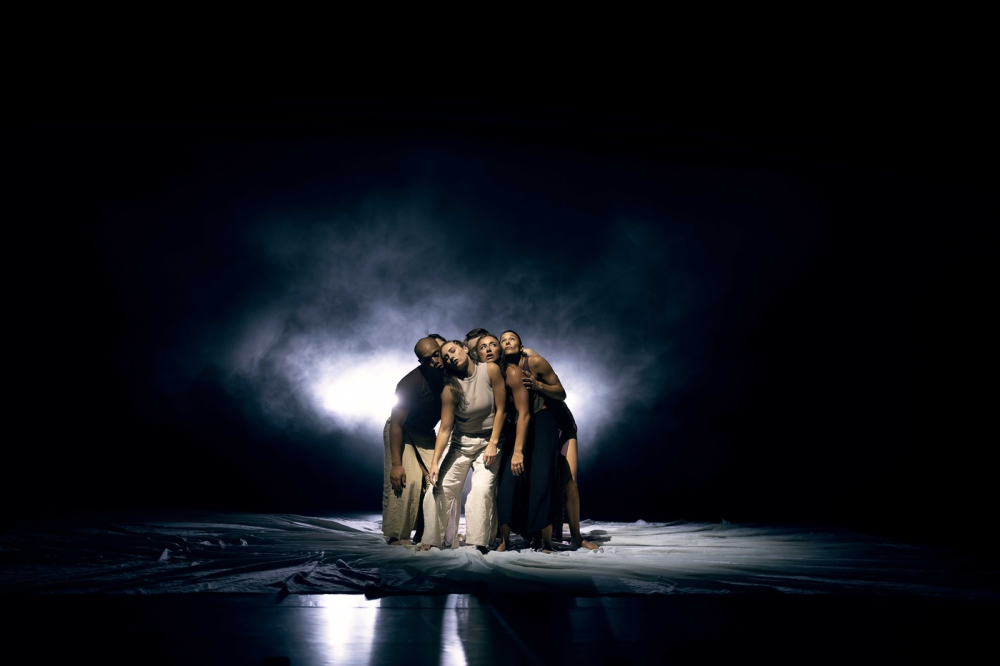Tāwhiri Warehouse
Wellington
9 March 2024
Reviewed by Mona Williams

Photographs by John McDermott
IMPRINT
Imprint is the first work in a stunning double bill. It is overwhelmingly satisfying; possessing complex indigenous symbolism, psychological profundity and movement vocabulary anchored in the depths of Aotearoa. Six dancers present a bravura performance. One cannot meet this work halfway; it invites complete self-immersion. Spoken comments, murmuring voices, a unique haka and a liturgical Gloria in Te Reo all attest to the mahi’s unmistakable Aotearoa identity.
Opening with stylized embraces and disengagements, they evoke the sea’s fluid, loving sweep along the shore, the snows crowning the peak of Aoraki; the jolting quakes tearing the fabric of the motu and geysers gushing steamy sensuality from the womb of the whenua. Joyfully throwing a female into the air, supple back bends, and the frenetic tempo of a male solo; arresting variations of stylized arms held aloft by the corps, disciplined execution of turns, and lifts of male dancers, all are interwoven with playful interludes and fluidity in pas de trois, duets, women’s floor-level solos and rearrangement of geometric patterns.


Like the woven flax garment anchoring the feathers that embellish the Maori cloak, (the kahu huruhuru,) the breadth of the soundscape affords the choreographers opportunities for extravagant interpretation. A rhythmic heartbeat, cello with drums, choric chant, strings at once melodic, then superseded by percussive, staccato beats of stone instruments; and a woodwind’s phrases resembling a bone flute’s, all undergird and transpose into uncompromisingly indigenous expression. The piece de resistance is the unpredictable lighting. There are lightning flashes, a magnetizing white spot on the stage floor and white light that projects the dancers as silhouettes against a lowered screen. A row of bulbs bursting into blue light with a ‘boom’ is startling. Ultimately, the limb, gathering the floor covering as if it were white sea-foam, leaves the final visual imprint of a lone black hand on a tilted screen.
“I am you. You are me!” the words of joint choreographer Rodney Bell, who, with Malia Johnson, dancers and skilled technicians, mounted this masterpiece. I experienced this abstract work as the desire for connection. Hearing the chant of the Gloria felt like wrestling with the Divine. “Brilliant!” was the universal audience response I heard appraising this world-class performance.
UKU – BEHIND THE CANVAS
Uku: The Maori Myth of the Formation of Hineahuone
An extract from a story of how Hineahuone came into being relates that:
Tāne called out, ‘We are seeking the path to woman. This is what we are doing.’ They replied, ‘Go to the soil at Kurawaka, there to go about your work. There the woman can be found, untouched, select and sacred, for she possesses the essence of humankind.’ They went and arrived at the soil of Kurawaka. The bones took shape and then the head. The arms, the body, the limbs, the thighs, these all took shape and the skeleton was complete …
Hineahuone Comes Alive
Noise, like a helicopter’s thunderous arrival to a sacred grove, shakes the audience powerfully into witnessing an earth splitting moment; the creation of woman. Chanting a spell in Te reo, dipping fists-full from the earth, smearing and patting potter’s clay on arms, legs, torso and upper body, a figure brings itself into human life-form. The audience connects immediately at a visceral level with this vision of clay creation. It is familiar, because of the (West’s stories of the) use of clay, yet unfamiliar in the Maori method of its use.


Dancing against a backdrop of greys, white and striated stonework walls, this brutalist environment provides an excellent context for witnessing the emergence of one, then of three primeval women. Their communing reflects a clarity of understanding. They move with assured facility but with little gentleness. The corps of six dancers fills the stage with vibrant fluidity, mind probing formations, yet cliché-resisting vocabulary. In costumes featuring black pants and clay splattered ‘aprons’ the males are bare to the waist, the better to emphasize repeatedly the clay, liberally applied, signifying humanity’s connection with and genesis from the crust of the earth. The women, smearing clay into their hair and upper body, splattering their pants, merge into the mists of time, or is it into the smoke expelled from Aotearoa’s volcanic womb? Graceful arcs of the arms echoing the movements familiar to kapa haka performances contrast with symbolic formations fresh for the eye but with a potency that hits where the soul resides.
The production boasts an aural feast of choral music, screams, male and female voices sometimes in two-part harmony, guitar, bells, vocalization, helicopter noise again, Te reo statements and conversations mildly poking fun at The New Zealand School of Dance. In this mythical world of woman’s creation, the audience views new truths presented through indigenous Maori dance vocabulary. Learning is transmitted from the sacred soil through the dancers’ soles to their mud–topped brain. Although the stage is dimly-lit for most of the dance, and the end is subdued, I felt the myth had led the audience into an entirely admirable new ‘world of light’.
Photographs by John McDermott
Gallery is loading. Please wait. Javascript will need to be enabled to view it.

